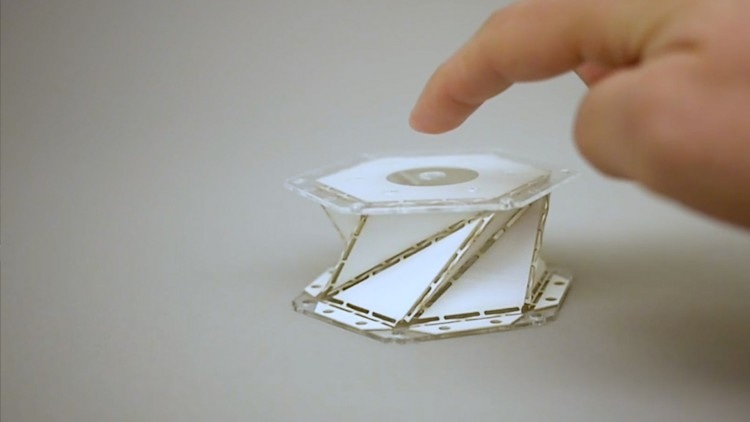May 27 2019
Space vehicles such as SpaceX’s Falcon 9 are intended for reuse. However, this implies that just like Olympic gymnasts leaping for a gold medal, they should stick their landings.
 Inspired by the paper-folding art of origami, a University of Washington team created a paper model of a metamaterial that uses “folding creases” to soften impact forces for potential applications in spacecraft, cars, and beyond. (Image credit: Kiyomi Taguchi/University of Washington)
Inspired by the paper-folding art of origami, a University of Washington team created a paper model of a metamaterial that uses “folding creases” to soften impact forces for potential applications in spacecraft, cars, and beyond. (Image credit: Kiyomi Taguchi/University of Washington)
Landing is challenging on a rocket’s legs since they must deal with the force from the impact with the landing pad. One means to tackle this is to construct legs made of materials that absorb some of the force and soften the blow.
Scientists at the University of Washington have created a new solution to help decrease impact forces—for possible applications in cars, spacecraft, and much more. Motivated by the paper-folding art of origami, the group developed a paper model of a metamaterial that employs “folding creases” to lessen impact forces and rather elevate forces that relax stresses in the chain. The research group reported its outcomes in Science Advances on May 24th, 2019.
If you were wearing a football helmet made of this material and something hit the helmet, you’d never feel that hit on your head. By the time the energy reaches you, it’s no longer pushing. It’s pulling.
Jinkyu Yang, Study Corresponding Author and Associate Professor, Aeronautics and Astronautics, University of Washington
Yang and his group developed this new metamaterial in a way that it possesses the preferred properties.
“Metamaterials are like Legos. You can make all types of structures by repeating a single type of building block, or unit cell as we call it,” he said. “Depending on how you design your unit cell, you can create a material with unique mechanical properties that are unprecedented in nature.”
The scientists resorted to the art of origami to develop this specific unit cell.
Origami is great for realizing the unit cell. By changing where we introduce creases into flat materials, we can design materials that exhibit different degrees of stiffness when they fold and unfold. Here we’ve created a unit cell that softens the force it feels when someone pushes on it, and it accentuates the tension that follows as the cell returns to its normal shape.
Yasuhiro Miyazawa, Study Co-Author and Doctoral Student, Aeronautics and Astronautics, University of Washington
As with origami, these unit cell prototypes are made from paper. The scientists used a laser cutter to cut dotted lines into the paper to specify the place to fold. They folded the paper along the lines to develop a cylindrical structure and subsequently adhered acrylic caps on either end to link the cells into a long chain.
The scientists aligned 20 cells and attached one end to a device that induced and started out a reaction throughout the chain. They used six GoPro cameras to monitor the initial compression wave and the subsequent tension wave as the unit cells returned to normal.
The chain made up of the origami cells demonstrated the counterintuitive wave motion: Although the compressive pushing force from the device initiated the entire reaction, that force never got to the other end of the chain. Instead, it was substituted by the tension force that set off as the first unit cells returned to normal and propagated faster and faster down the chain. Thus, the tension force was experienced only by the unit cells at the end of the chain pulling them back.
“Impact is a problem we encounter on a daily basis, and our system provides a completely new approach to reducing its effects. For example, we’d like to use it to help both people and cars fare better in car accidents,” Yang said. “Right now it’s made out of paper, but we plan to make it out of a composite material. Ideally, we could optimize the material for each specific application.”
Additional co-authors include Hiromi Yasuda, a postdoc at the University of Pennsylvania who completed this research as a UW aeronautics and astronautics doctoral student; Efstathios Charalampidis and Panayotis Kevrekidis at the University of Massachusetts; and Christopher Chong at Bowdoin College. This study was funded by the National Science Foundation, the Office of Naval Research, and the Washington Research Foundation.
Origami-inspired material designed to soften impact